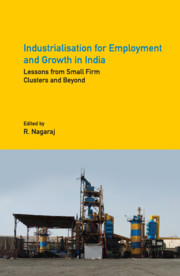Book contents
- Frontmatter
- Contents
- List of Tables
- List of Figures and Maps
- Preface and Acknowledgements
- 1 Introduction
- 2 Garment Cluster in Kolkata: The Untold Story of Expansion Relying on Low-end Domestic Demand
- 3 Constraints to Upgrading and Employment Expansion in the Tiruppur Knitwear Cluster
- 4 Determinants of Employment in the Indian Automobile Industry
- 5 Upgrading Technology and Space as Collective Strategy: Creation of Jobs and Market Potential in Gujarat’s Ceramic Clusters
- 6 Sports Equipment Manufacturing in India: A Firm-level Inquiry into Growth and Employment Dynamism
- 7 Aligarh Lock Cluster: Unravelling the Major Impediments
- 8 Continued Misery or a Change in Fortune? The Case of the Howrah Foundry Industry
- 9 Redevelop and Perish, or Survive and Grow? The Case for Supporting Informal Leather Enterprises in Dharavi, Mumbai
- 10 Growth Performance, Competitiveness and Employment in MSMEs: A Case Study of the Rajkot Engineering Cluster
- 11 Manufacturing and Automation
- About the Contributors
- Index
4 - Determinants of Employment in the Indian Automobile Industry
Published online by Cambridge University Press: 31 July 2021
- Frontmatter
- Contents
- List of Tables
- List of Figures and Maps
- Preface and Acknowledgements
- 1 Introduction
- 2 Garment Cluster in Kolkata: The Untold Story of Expansion Relying on Low-end Domestic Demand
- 3 Constraints to Upgrading and Employment Expansion in the Tiruppur Knitwear Cluster
- 4 Determinants of Employment in the Indian Automobile Industry
- 5 Upgrading Technology and Space as Collective Strategy: Creation of Jobs and Market Potential in Gujarat’s Ceramic Clusters
- 6 Sports Equipment Manufacturing in India: A Firm-level Inquiry into Growth and Employment Dynamism
- 7 Aligarh Lock Cluster: Unravelling the Major Impediments
- 8 Continued Misery or a Change in Fortune? The Case of the Howrah Foundry Industry
- 9 Redevelop and Perish, or Survive and Grow? The Case for Supporting Informal Leather Enterprises in Dharavi, Mumbai
- 10 Growth Performance, Competitiveness and Employment in MSMEs: A Case Study of the Rajkot Engineering Cluster
- 11 Manufacturing and Automation
- About the Contributors
- Index
Summary
Introduction
Employment generation in India has been skewed in favour of services since early 2000 (GOI 2018), reflecting the sectoral gross domestic product (GDP) shares of manufacturing and services at 17 per cent and services at 53 per cent, respectively. But as the employment growth in services tapers off, one needs to re-examine the role of the manufacturing sector in creating jobs. To be specific, labour-intensive industrialisation is a term that needs elaboration to understand the role of specific sectors and their interlinkages to the local and global economies. In a sense, one needs to reimagine labour-intensive industrialisation in the manufacturing sector and the possible strategies for the same.
Historically, industrialisation strategies depend on factor endowments. A country's direction of trade also signifies its nature of industrialisation. If a country exports labour-intensive goods and imports capital-intensive goods, it follows labour-intensive industrialisation. Over time, as the quality of skill and education improves, the character of exports also improves qualitatively with an improvement in living standards. This is the transition that is targeted by emerging economies with abundant labour endowment. The definition of labour intensive, however, can be relative. For example, despite being more capital intensive than traditional industries such as textiles, the automotive industry is relatively labour intensive in comparison to its counterparts in developed countries. Further, only specific processes such as transfer presses, paint shop and welding operations are capital intensive whereas assembly operations and parts manufacturing are outsourced to the upstream section of the value chain consisting of structured suppliers in the automotive ancillary industries. The contribution of the global automotive industry to GDP ranges between 3 and 7 per cent while the employment share ranges between 5 and 15 per cent in the developed and emerging economies, respectively.
The present chapter analyses the employment potential of the Indian automobile industry, which is a technology-intensive industry with extensive backward and forward linkages. The automobile industry is composed of the original equipment manufacturers (OEMs) and the auto component manufacturers, which come under different National Industrial Classification (NIC) codes.
- Type
- Chapter
- Information
- Industrialisation for Employment and Growth in IndiaLessons from Small Firm Clusters and Beyond, pp. 72 - 99Publisher: Cambridge University PressPrint publication year: 2021



